Apollo Insurance CoversCompiled by Howard C. Weinberger |
|||||||||||||||||
DisclaimerIt is important for collectors to note that this is a guide and an assembly of what is believed to be the best information available on the Apollo Insurance Covers, but it is not the end of the discussion and does not pretend to be the last word. This disclaimer precedes the article because the ideas and opinions contained herein may be unsettling to some collectors. IntroductionDuring the great space race, our nation's pioneering astronauts were treated like modern day music and movie stars. Collectors inundated them with autograph requests. Ironically, and strangely fitting, these same astronauts came to use their own autographs, as a special form of insurance to financially protect their families should their mission fail. And in doing so, they created one of the hobby's more unique and complex autograph collectibles sought after by most serious vintage space autograph collectors. During the Apollo lunar program of the late 1960s and early 1970s, the individual missions were considered so dangerous and hazardous that the astronauts could not secure adequate private life insurance for their families, or at least this is the popular myth. In reality, they could get insurance - although NASA was not allowed to pay for it - but they just couldn't afford it. The dangers were so high that the premiums were out of reach for their salaries at the time. However, quietly, and unbeknowst to the general public, some third parties stepped in, and covered a basic insurance premium package for them (see footnote for more details). Independently of this, the astronauts decided to provide their families with a tangible asset should their mission fail, in the form of the "Insurance Covers". The Apollo astronauts signed a series of philatelic covers in preflight quarantine that were then postmarked and canceled on either the day of the launch or on the day they landed on the Moon. These covers were then dispersed to designated family members for long-term safekeeping. Should the astronauts not return from their mission, the family could sell the signed covers to collectors, providing the family with a considerable amount of financial security. They are unique to the Apollo era and perhaps unique in all of autograph cover collecting. The Insurance Covers were the idea of Matthew and Eunice Radnofsky of Seabrook, Texas. They produced them, along with members of The Manned Spacecraft Center Stamp Club (MSCSC) in Houston, Texas. Eunice was the correspondence handler for the stamp club. It all started with Apollo 11. The covers were not done officially and mainly the stamp club in Houston arranged for most of the logistics for each Apollo crew. The MSCSC and then the astronaut families kept the covers while the missions were underway. After they returned safely, the covers were stored away or dispersed in various ways. No NASA or official record was kept because they were private and personal items of the astronauts. NASA may have given their official OK for the astronauts to create them, but they were just something that the astronaut crews did themselves with much help from the MSCSC. The club went on to produce MSCSC cachet covers for the subsequent Apollo lunar missions. Space autograph collectors are fascinated by these covers and the special role they played in allowing the astronauts to have peace of mind in their work, knowing that their families would have some financial security should their mission fail under dire circumstances. Insurance Covers are also one of the best ways to acquire a guaranteed set of authentic crew signatures. SpecificsInsurance Covers started with Apollo 11 and continued on until the Apollo 16 lunar voyage. There were for various missions more than one design or type of cover; Apollo 11 (3 types), Apollo 12 (2 types), Apollo 13 (2 types), Apollo 14 (2 types), Apollo 15 (1 type), and Apollo 16 (1 type). Insurance Covers were NOT signed by the crewmembers just hours before their launch to the moon. The crew would usually enter crew quarters about a month before their scheduled launch. In between their training and other astronaut/and crew assigned duties, as time permitted, crewmembers - sometimes individually - would autograph their covers. Sometimes even different pens and inks were used (i.e. the Apollo 11 cachet types) as batches were signed at different times within the few weeks before their moon-bound voyages. One important factor that must be met in order to qualify as an "Insurance" Cover is the origin of the cover. It must come from an appropriate source (i.e. a crewmember, family member, or friend) in which the cover was held for insurance purposes from the original batch, and that may be difficult to prove if the cover has had a multiple-owner history. That is one problem with the MSCSC Insurance Covers in that they are identical to those that were also available to collectors, so it's possible that some were canceled for the flight but signed by the crews after the mission, which, of course, would not make them Insurance Covers. This is why a cover's certification is key, as it assures that a cover is an authentic Insurance Cover. It is important to have a certification letter from a crewmember, their family or friend who knew of the cover's origin. Better yet, having the reverse of an insurance cover directly certified by a crewmember is probably the most desirable format. Aside from the MSCSC covers, there were special printed insignia covers, known both as the "astronaut-insignia" and/or the "Bishop" covers, named after their creator Al Bishop, an aerospace public relations specialist who had contact with the astronauts. After hearing about the Apollo 11 philatelic practices that originated from the Houston stamp club, he wanted to direct and control another special cachet designed cover of his own for the astronauts' and their families exclusively. Thus, this is what created the first "insurance astronaut-insignia" cachet designs, a crew patch/mission emblem cachet and various insignia, such as astronaut and/or military symbols, which were incorporated into the cachet design of high-quality rag content envelopes. A printing company in Cocoa, FL, not Houston, produced the special cachet covers, starting with Apollo 12 to Apollo 16. The astronaut-insignia covers had nothing to do with the MSCSC, even though Apollo crews still maintained contact with them in signing and using (even flying some to the moon) their stamp-club cachets. The Bishop covers are unique; in that the cachet design was printed exclusively for the crew, families and friends and were not made available to collectors. They were produced in fewer quantities than the MSCSC envelopes from Houston and likely not more than 1,500 were produced. In the cases of both types of covers, there were a number left over and many were stamped and canceled but not signed. As time went by, many of these were sold and dispersed and some later signed by one or more of the astronauts. But these are NOT Insurance covers, as the crew did not sign them preflight. These left over covers are generally referred to as "Insurance-type" Covers and pop up from time to time. Numbers? Who knows? Probably at least 500+ for each mission would be in the ballpark. But some flights had fewer done, with probably Apollo 13 and 16 the smallest number and Apollo 12 Bishop covers and Apollo 15 covers the most, while the Apollo 11 and 13 covers are currently among the most expensive. Apollo 11's are expensive because of it being Apollo 11, even though a fair number of Apollo 11s probably exist. Apollo 11 CMP Mike Collins was asked if he could verify how many insurance covers were done for Apollo11 and while he could not confirm the exact number, he said that he believed the number was maybe a 1000 in total. Advisory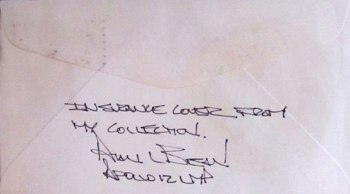
An Apollo 12 Insurance Cover explicitly certified Collectors are advised to acquire Insurance Covers that are directly from astronauts or their families whenever it is possible, even if at an additional cost. It is likely that Insurance Covers that are directly certified on the reverse of the cover by a member of the representative crew will become the most treasured in the future because they cannot be questioned as to what they are. It is realized that hundreds of likely Insurance Covers have been sold over the years by astronauts, their families and by collectors, and the thought of having each certified was never really considered. However, as more research has surfaced, it does seem that many of the covers that have the characteristics of Insurance Covers may actually just be signed covers and not of the original lots that were put aside as intentional Insurance Covers. | |||||||||||||||||
Identification GuideThe essence of Insurance Covers is that they were signed before the flight. The cover descriptions below demonstrate that Insurance Covers were canceled primarily on the date of launch with a few depicting moon landing or splashdown dates. Apollo 11Apollo 11 insurance covers were affixed with the Scott 1371 six-cent postage stamp, which depicts the Apollo 8 Earthrise and the words "In the beginning God..." 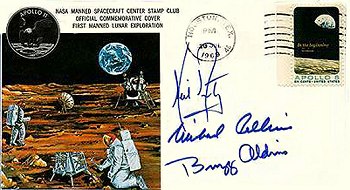
Type 1 - The Manned Spacecraft Center Stamp Club (MSCSC) Cachet of the astronauts on the moon - Houston canceled on the July 20, 1969 Moon landing date. 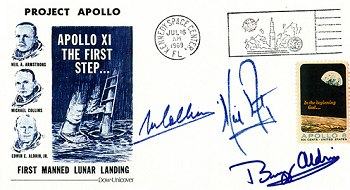
Type 2 - Dow-Unicover - KSC canceled on the July 16, 1969 launch date. 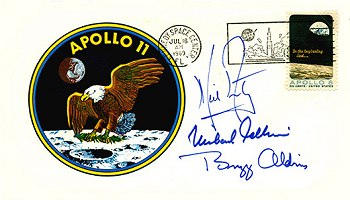
Type 3 - Mission Emblem cachet - KSC canceled on the July 16, 1969 launch date. Astronaut Tom Stafford had possession of the Apollo 11 covers when the crew launched. He arranged for some of them to be canceled on launch day at KSC and then carried all of them in his T-38 back to Houston. He then arranged for the remainder to be canceled in Houston on the day of the moon landing (apparently, the canceling machine at the Houston post office was going haywire that day, as many of the covers have really ugly cancellations). It was planned to use most, if not all, of the MSCSC cachet envelopes for postal processing when Armstrong and Aldrin landed and walked on the lunar surface. Just about all of those covers were machine cancelled from Houston, TX, (4A) on July 20, however, some did in fact contain a "roller hand-cancel" impression while others were "missed" by a circular date during their cancel application. The covers were then distributed to the 3 families. When NASA's Manned Spacecraft Center Stamp Club (MSCSC) approached Michael Collins about the possibility of providing the crew with Apollo 11 postal covers, it was decided by all the crewmembers to include - not just the club's own printed cachet envelope - but two other popular "on the market" so-to-speak cachet designs of Dow-Unicover and the official mission patch, both of which, originated from the on-base Kennedy Space Center. We know that 214 of the covers were flown by the crew to lunar orbit and that Aldrin and Collins had reported earlier that "hundreds," or just about the same amount that were flown, were kept behind (all 3 cachet types) as the so-called first insurance or contingency covers. No one knows for sure of the exact quantity of covers that were purchased - at production cost - by the crewmembers that were signed and left behind. The Aldrin family had many (Joan for certain) as did the Collins family. Similar covers, all signed by the crew in advance before their moon-bound trip, have also surface that were in the possession of various personnel that worked exclusively inside the astronauts' personal or crew quarters while at KSC, and many with NO postal cancels! A box of covers - probably at least a hundred covers? - Signed by Armstrong/Aldrin/Collins was stolen from the KSC Crew Quarters that were intended to be used as Insurance covers for Apollo 11. But no one knows what happened to them or if they were even canceled. If they weren't canceled for the Apollo 11 launch, then if any uncanceled crew signed Apollo 11 covers appear, or canceled for an Apollo 11 anniversary, then they could be from the stolen box. It's a real mystery about what happened to these covers. Just for clarification purposes, as stated above, the MSC Stamp Club (MSCSC) only produced and had printed 1 of the 3 insurance type covers that were used by the Apollo 11 crew. The NASA Exchange Council produced the crew insignia covers for the first crewed lunar landing mission at Kennedy Space Center, and Apollo 11's Dow-Unicover cachets were designed by a KSC graphic design worker and were printed in the Orlando, FL area. Apollo 12Apollo 12 insurance covers were affixed with the Scott C76 ten-cent "First Man on the Moon" postage stamp and were KSC canceled on the November 14, 1969 launch date. 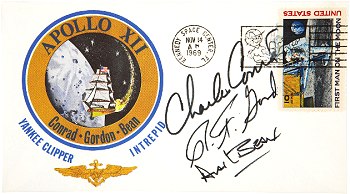
Type 1 - (Bishop) Mission Emblem cachet w/Navy wings 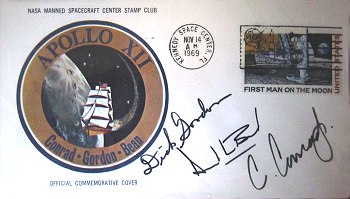
Type 2 - Mission Logo w/Manned Spacecraft Center Stamp Club (MSCSC) wording at top and bottom Apollo 13Apollo 13 insurance covers were affixed with the Scott 1338 six-cent postage stamp, which depicts the flag over the White House and were KSC canceled on the April 11, 1970 launch date. 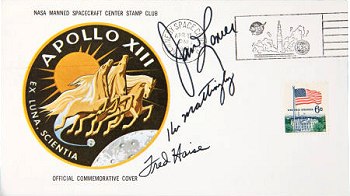
Type 1 - Mission Logo w/Manned Spacecraft Center Stamp 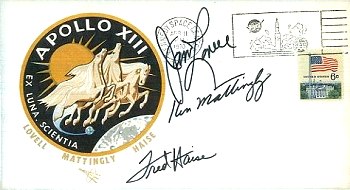
Type 2 - (Bishop) Mission Emblem cachet w/crew names in gold print underneath and astronaut pin insignia. Apollo 14Apollo 14 insurance covers were affixed with the Scott 1371 six-cent postage stamp, which depicts the Apollo 8 Earthrise and the words "In the beginning God..." and were KSC canceled on the January 31, 1971 launch date. 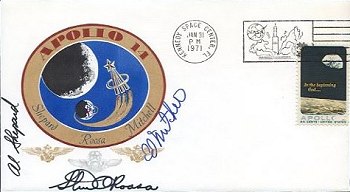
Type 1 - (Bishop) Mission Emblem cachet w/Navy wings (Shepard), Air Force wings (Roosa), and Navy wings (Mitchell) underneath. 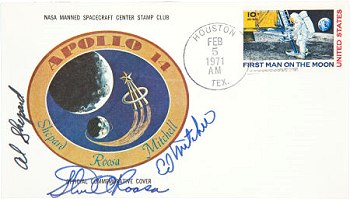
Type 2 - Mission Logo w/Manned Spacecraft Center Stamp Club (MSCSC) wording at top and bottom. Apollo 15Apollo 15 insurance covers were KSC canceled on the July 26, 1971 launch date. 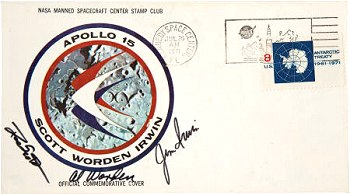
Type 1 ONLY - Mission Logo w/Manned Spacecraft Center Stamp Club (MSCSC) wording at top and bottom. These covers were affixed with the Scott 1431 eight-cent postage stamp, which commemorated the 10-year anniversary of the Antarctic treaty. The Dave Scott-chosen Antarctic design, an 8-cent first class issue that was available at the time of the lunar voyage, was an appropriate theme, it was thought, for space cover uses. Even though the stamp commemorated a ten-year treaty, there was an "exploration" sort-of "look" to it; also, it contained red, white, and blue colors. Apollo 16The Apollo 16 insurance covers were affixed with either the Scott 1434 (Earth and LM) or the Scott 1435 (Lunar Rover) "Decade of Achievement" eight-cent postage stamps and were KSC canceled on April 16, 1972 launch date. 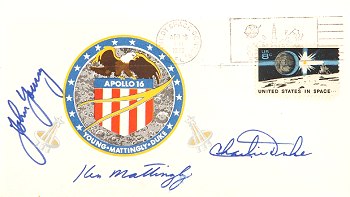
Type 1 ONLY - (Bishop) Mission Logo w/astronaut pin insignia both on the right and left. Apollo 17 Insurance "Type" CoversIn regard to insurance covers for Apollo 17, mostly the MSCSC cachet covers were used by the crew for signing and no Bishop covers were produced as NASA and the astronauts wanted to distance themselves from any further "special" philatelic ties, mainly because of the prior Apollo 15 cover "scandal." The crew signed Apollo 17 MSCSC covers before and after the lunar trip, apparently though, in small numbers and without any reference or tie to the so-called "Insurance Cover" label. However, it was still a fact that the covers would create value for the astronaut families should they not return, but discretion was used, even among the crew families, as evidenced by the discovery of a handwritten note, dated the week before launch, by Apollo 17 CMP Ron Evans, that was with a stash of covers left with his wife, that read "These envelopes are for Jan Evans to be used as she desires Ronald E. Evans 12/4/72" Full crew signed covers are the scarcest as we speculate that Schmitt was not a willing signer, probably due to not being married nor having children, so the majority of Apollo 17 Insurance Covers are mostly signed just by Cernan and Evans. 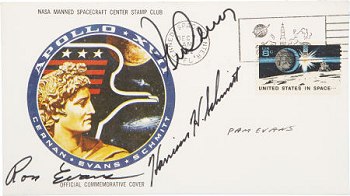
Apollo 17 insurance "type" cover So, a few Apollo 17 Insurance Covers do exist, but they are few and were kept close to the vest because of the prior scandal and the risk to the careers of the crew if they went against NASA policy. One characteristic to confirm if a Apollo 17 cover was likely signed preflight (of the era) is that the Cernan signature would not be underlined. He did not underline his last name on his early signature. Problems with Insurance CoversThe story of the Insurance Covers is fascinating, and one that attracts many collectors to the idea of assembling a collection. The intent of this report is to provide the most accurate information from the most respected sources and to set the benchmark so collectors will be well informed. That said, absolute certainties about insurance covers are difficult to come by. They existed but they were unofficial so no records were kept by anyone. In many cases too, where astronauts are deceased and/or memories have faded, it has been difficult, in some cases, to ascertain which types were insurance covers and which were not. As is the usual protocol, the default is to accept the word of the astronauts because they were there and they maintain the highest level of integrity in regard to artifacts being presented correctly. Going forward, I believe that the collecting community will require certification from an astronaut, his family or other credible source, to be considered an official insurance cover, with the best certification being the notation by an astronaut on the reverse of the cover itself as it being one. The criteria needed to be considered an insurance cover is:
Although the first criteria can be reasonably assured, the second can not because of the fact that the astronauts had relationships with the stamp club and signed many covers for them, and they also gave away some to friends and associates within KSC. These covers still represent the essence of a cover having been signed preflight, but not the second, so they may have to be reconsidered as "Insurance Type" Covers. This will obviously upset many because the idea of certification has only really become important in the last few years, and most of those covers floating around, that may indeed be insurance covers, are not certified as such. It is a dilemma for sure, but the topic needs guidelines and this seems to be the most certain way for a collector to know what he or she has. When I explained this point to Mike Collins, he replied with the question, so what are you going to do about all the covers that have been given away over the years? And the cold, hard answer is, it's a shame! At the very least, a cover with certification will carry a premium to one without, which will be accepted as an Insurance-Type Cover. All data within was compiled from information available on the web and magazines that was provided to collectors over a period of years and by knowledgeable collectors and dealers in the field of space collecting, including Ken Havekotte, Robert McLeod, Rich Jurek and Howard C. Weinberger. The life insurance policies of the Apollo astronautsFootnote by Chris Spain & Richard Jurek Like most popular myths the idea that the Apollo astronauts could not get life insurance contains a kernel of truth - NASA was forbidden by government regulations to pay for life insurance for the astronauts, and the astronauts on their regular government salaries were not able to afford the premiums necessary to provide themselves private insurance. This did not mean, however, that the astronauts went uninsured. Prior to Apollo 11 the astronauts had been covered with a $100,000 insurance policy apiece during their trips (equivalent to roughly $600k in inflation adjusted dollars), jointly paid for by Life Magazine and the World Book Science Service. For Apollo 11, the Travelers Insurance Co, of Hartford, Conn. approached the astronaut office offering to provide their insurance, with the premiums being paid for by two Houston firms, the Austral Oil Company and the Cullen Central Bank. According to Earl Bells, a manager at Travelers' Houston office who set up the Apollo 11 insurance policy, Neil Armstrong forbade any publicity about this deal. According to Bell this lack of publicity made it very difficult to find anyone to pay for the Apollo 12 insurance premiums, but in the end a group of businessmen finally paid for $50,000 premiums for each astronaut (equivalent to roughly $300k today). The Apollo 13 astronauts were each provided a free $100,000 insurance policy by Houston financier Frank W. Sharp who owned the National Bankers Life insurance firm, but the near-disaster of the Apollo 13 mission highlighted the dangers of space travel and again complicated the provision of insurance for subsequent missions. The Washington-based National Space Club Scientific and Educational Foundation stepped in to pay for the premiums of the Apollo 14 crew when no one else would, at the urging of Texas Congressman Olin (Tiger) Teague, a member of the House of Science and Astronautics Committee, whose chairman Rep. George P. Miller happened to be one of the trustees of the foundation. And so it went on with subsequent flights as this foundation and other organizations continued to provide life insurance policies for the moon-bound astronauts. The astronauts thus never flew without life insurance but this cover was almost entirely out of their control and in some cases only finalized a few weeks before the flights. In this context it's easy to see why the astronauts sought to provide something for their families that was both tangible and entirely within their control in the form of the Apollo Insurance Covers. | |||||||||||||||||
|
Legal Disclaimer: While every effort is made to ensure that the content of this website is accurate, the website is provided "as is" and I make no representations or warranties in relation to the accuracy or completeness of the information found on it. Nothing on this website should be taken to constitute professional advice or a formal recommendation and the author excludes all representations and warranties relating to the content and use of this site. In no event shall the author be liable for any incidental, indirect, consequential or special damages of any kind, or any damages whatsoever, including, without limitation, those resulting from loss of profit, goodwill, income, or anticipated savings, whether or not advised of the possibility of such damage, arising out of or in connection with the use of this website or any linked websites. | |||||||||||||||||